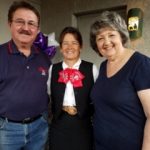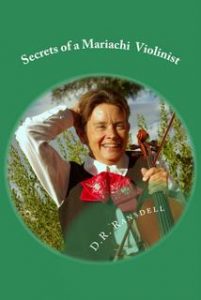D.R. Ransdell is a writer and musician. She spent five years in Mexico  teaching English and learning folk songs. Now, she plays with a mariachi group and writes a murder mystery series about mariachi bandleader Andy Veracruz. She also teaches writing at the University of Arizona. Here’s her take on The Hard Work of Telling the Truth: Moving from Fiction to Non-Fiction.
teaching English and learning folk songs. Now, she plays with a mariachi group and writes a murder mystery series about mariachi bandleader Andy Veracruz. She also teaches writing at the University of Arizona. Here’s her take on The Hard Work of Telling the Truth: Moving from Fiction to Non-Fiction.
At Bouchercon last September, Catriona McPherson explained that she had graduated with high honors from the University of MSU—Make Stuff Up. Evidently I was a classmate! I too love to make stuff up. As an only child until I was nine, I was forced to create my own worlds. I remember running around the basement with my little sheriff badge and gun holster while chasing bad guys, and flapping my arms while pretending I was Peter Pan. When I’m writing, I love to create scenes, invent dialogues—design my fictional world according to my preferences. Hence when I took on the challenge of writing non-fiction, the task was monumental!
 For years I’ve played mariachi music. Experiences in the band led me to create Andy Veracruz, a mariachi violinist who stars in his own mystery series. But when I tried to write about my true-life experiences, I stumbled.
For years I’ve played mariachi music. Experiences in the band led me to create Andy Veracruz, a mariachi violinist who stars in his own mystery series. But when I tried to write about my true-life experiences, I stumbled.
At first I suffered simple resistance. A friend kept saying, “You should write all this stuff down.” She was enthralled with my stories of mariachi gigs gone bad, bad mariachi players, bad guest singers—the kinds of normal experiences you have when playing five nights a week in a folk music group. Every few months Cookie would ask if I’d started writing yet. Then one day I was inspired after hearing Gioia De Cari talk about her experiences as one of the few females in M.I.T.’s graduate math program. As I left the theatre I knew two things: I was awfully glad I hadn’t studied math, and I needed to find a way to share my musical  adventures.
adventures.
That night I started writing. Cookie had told me to write everything down—and I did! Big mistake. After eight months of hard work, I’d written 112,000 words! That was only a first draft, so I honed it down, and the result was a mere 105,000. Not bad for years of mariachi playing, right? After two more drafts, I passed off the results to two trusted beta readers.
They told me the manuscript was boring. Gilbert Velez, D.R. & Cookie
Ouch.
My biggest mistake? I tried to stick to the facts. I recorded the events in chronological order and included every detail. I was true to my experience! But that was much too much for any reader besides Cookie.
For a long time I was at a standstill. I was caught in hyperspace between the total fiction I was used to writing and the absolute truth I had drafted. And so the manuscript sat. And sat. Two summers later I was in Italy writing a travel piece when I realized: Oh. You tell the truth, kinda sorta. You write with the reader in mind, not the writer. You throw away details. You forget about “real time.” Instead you concentrate on cohesion so that the stories make sense in relationship to one another.
A Herculean task. It took me another three versions to get close to right, but this time my beta readers agreed: The manuscript was fun. It flowed. The stories were complete within themselves. Thus I had made big progress. But I still hadn’t finished. My beta readers complained that here and there I had been harsh—very harsh—about things I was still mad about. Those flashes of anger made me seem shallow without improving the memoir as a whole. Painfully I removed or softened those sections. I’m still mad about some recent events, but holding onto anger won’t change the past or help the future, so why dwell on negativity?
 Now that Secrets of a Mariachi Violinist has been published, I’m delighted to return to a fictional world where I’m in control of every action, setting, and thought. Eventually my dance with non-fiction will continue with more travel pieces, but for the moment I feel right at home. I’m back at MSU where anything can and does happen just the way I want it to!
Now that Secrets of a Mariachi Violinist has been published, I’m delighted to return to a fictional world where I’m in control of every action, setting, and thought. Eventually my dance with non-fiction will continue with more travel pieces, but for the moment I feel right at home. I’m back at MSU where anything can and does happen just the way I want it to!
What have been your own experiences going back and forth from fiction to non-fiction? Which do you find easier? Which kind of writing do you prefer and why?
Leave a comment, even if you don’t play in a Mariachi band. Thanks.
For more details, please visit: http://www.dr-ransdell.com

I found your comments about writing non-fiction most interesting. I thought non-fiction would be much easier to write. Could it be that non-fiction comes more from the heart thus making it more emotional for the writer where as fiction comes from the author’s imagination?
Funny, I have always had more trouble making things up. However, I am afraid in both instances my writing tends to be rather dry… I think you are ahead of me there!
I can see how it would be more fun to have character’s dialogue flow through your head than to have to battle with memories and what to leave in or take out. It makes sense to me. Now if only characters would oblige me and appear. Ah well, for me at least, I might have to stick to facts. I did enjoy your foray into past. Thanks for battling through the journey.
It sounds like you’re a non-fiction writer, and that’s good too! The world would be a mess if all of us wanted to write fiction instead. But yes, characters do come to me. I might be swimming, and there they are having a dialogue whether I want them to or not. Then I have to rush to the nearest writing tablet and get it all down.
For the memoir, I tried to remember the kinds of things people said, but of course I didn’t remember exactly. So far though, none of the participants have complained. So I guess I was true to character, at least!
Thanks for stopping by. It’s always good to know that other writers have the exact opposite experiences that you do!
Mostly I write fiction with only a smattering of some small true event tossed in. Currently working on a fourth cozy cat mystery, but about half the book will be a somewhat fictionalized account of my experiences in Austria in 1987. It should be interesting to see how my character reacts in the setting of that beautiful country full of cobbled streets, magnificent churches and fields full of sheep and cows, each wearing a bell. Sigh! So beautiful! How can this be a cat mystery???? I’m calling this a hybrid book. Can’t wait to see how it fits together…a challenge, indeed. I think I’ve created a new genre!!
Sounds interesting. Looking forward to it. Thanks for stopping by.
New genres are always good, Elaine! People want things that are familiar…. but also different.
I’ve been wanting to write a cat mystery. I have four cats now… and you know, they’re always observing me and other people. Of course, they have a lot of time to think things over since what they mostly do is sleep! Good luck with the book project!
I’ve had much the same experience as you. My first try at mystery after I retired as a professor resulted in a 123,000 words MBME (Most boring manuscript ever). What did I know? I had written mostly research articles for scientific journals. I tried to stick close to the truth in the mystery and continued to write in long, scholarly sentences. No one wanted that manuscript. Years, many years later, I redid the manuscript, honed it to around 72,000 words, made stuff up (lied) and published it.
Good to remember. I find that whenever I cut something out of my manuscript, it gets better. Thanks for the comment, Lesley.
Yeah, funny how when you tell the truth… it’s too much information and really, nobody wants to know that much! But I think I finally got it down to the right length. It was hard to let go, but my readers were much more impressed!